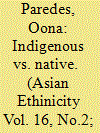|
|
|
Sort Order |
|
|
|
Items / Page
|
|
|
|
|
|
|
| Srl | Item |
| 1 |
ID:
137221


|
|
|
|
|
| Summary/Abstract |
Two categories of ethnic minority – Moro and Lumad – are indigenous to the Philippine island of Mindanao, with Muslim Moros outnumbering largely animist Lumads. Both have been profoundly displaced by the post-World War II influx of Christian Filipino settlers from other islands, leading to armed conflict with the national government over land and political control. Due to their political and demographic inferiority to Moros, Lumads have regularly resorted to the accommodation and assimilation of Moro priorities, including throwing their support behind the latters’ decades-long struggle for territorial autonomy. Thanks to wide public support among the Lumad and other Mindanao sectors, the latest peace talks between the government and Moro leaders has led to the signing of a major peace deal involving the creation of a new autonomous Bangsamoro homeland. Despite this, the legitimate needs of Lumad stakeholders have been ignored, and in some cases deliberately undermined, by Moros and the national government. This article analyses the post-conflict status of the Lumad who, as second-order minorities in the future Bangsamoro homeland, have been doubly marginalized in daily life and in the peace process. It concludes that denying Lumad concerns now will render Bangsamoro more vulnerable to legal and constitutional challenges, as well as jeopardize the unique ‘tri-people’ ethos that has made this the most firmly grounded peace process to date.
|
|
|
|
|
|
|
|
|
|
|
|
|
|
|
|
| 2 |
ID:
165108


|
|
|
|
|
| Summary/Abstract |
What are the practical and cultural consequences of embracing the ‘Indigenous’ label? Despite universalising aspirations, the concept of indigeneity carries distinct political connotations in the Philippines, where the Indigenous Peoples’ Rights Act has created a bureaucracy that purportedly responds to the special needs of Indigenous Peoples, including the preservation of cultural traditions and securing title to ancestral lands. While laudatory on the surface, in practice the current legal and bureaucratic framework allows the state to impose its own definition of indigeneity, often compelling indigenous minorities to conform to stereotypes in order to acquire the fundamental rights and benefits that, by law, are supposed to be guaranteed. The Philippine states’ requirements for being recognised as ‘Indigenous’ are transforming how Indigenous Peoples maintain and perform their ancestral traditions, often leading to highly divisive internal debates about proper cultural and political representation. This article examines the case of Higaunon Lumads in northern Mindanao, who have been responding locally to over thirty years of national trends in participatory development that require increased engagement with government bureaucracy. I explore how ‘indigeneity’ has been defined and employed by Higaunons in the service of ‘preserving tradition’, the political and other consequences that have emerged in this context, and the perils of representing and commodifying indigeneity in modern Southeast Asia.
|
|
|
|
|
|
|
|
|
|
|
|
|
|
|
|
|
|
|
|
|